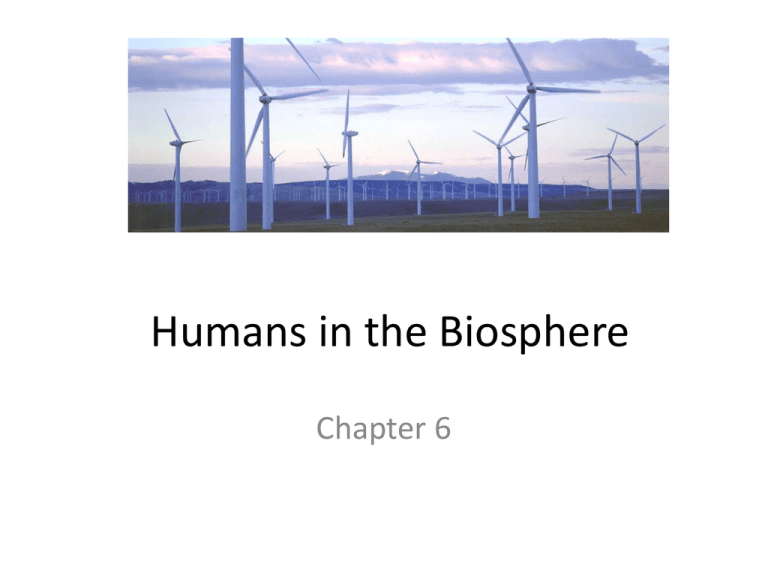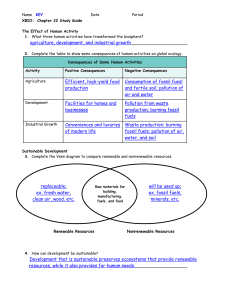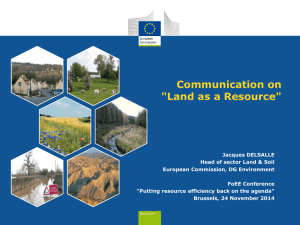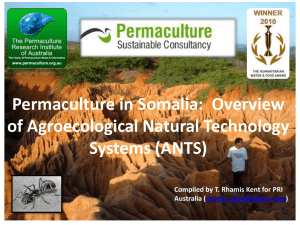Humans in the Biosphere
advertisement

Humans in the Biosphere Chapter 6 Changing Landscape • Activities affect environment • Relationship between resources and sustainable use Effect of Human Activity • Living on Island Earth – We affect environment when: • Obtain food • Eliminate waste products • Build places to live – Humans impact regional and global environments: • Agriculture • Development • Industry Which impact natural resources such as soil, water and the atmosphere. Effect of Human Activity Agriculture – Dependable supply of food that can be stored for future use – Monoculture-clearing large areas of land to plant a single highly productive crop annually (soybean) • Efficient sowing , tending, and harvesting of crops • Providing food for nearly 7 billion people-impacts natural resources – Fertilizer production and Farm machinery-consume large amounts of fossil fuels. e.g.-Canola Oil Soybean Effects of Human Activity • Development – Dense human communities produce lots of wastes. • Not disposed correctly they affect air, water and soil. – Consumes farmland – Habitat fragmentation Effects of Human Activity • Industrial Growth – Conveniences utilize a great deal of energy to produce and power – Energy comes from burning fossil fuels such as coal, oil and natural gas (emits greenhouse gases90 % of US emissions) – Past-dumped waste directly into air, water and soil Sustainable development • Goods-things that can be bought and sold and have value in terms of dollars and cents. • Services-processes or actions that produce goods. • Ecologically-these are goods and services produced by ecosystems that benefit the human economy. What type of goods and service? Ecosystem Goods and Services • Many natural and free of charge – Breathable air – Drinkable water • In environment cant provide-society must spend money to produce – E.g. many places drinkable water is free; source polluted or damages and water quality falls-must pay for water treatment to be safe. Renewable and Nonrenewable Resources Renewable • Can be produced or replaced by healthy ecosystem. • E.g. southern white pine that can grow back when an old tree dies or is cut down. Nonrenewable • Natural processes cannot replenish these goods within a reasonable amount of time. • E.g. fossil fuels (formed from buried organic material over millions of years) ; when depleted they are gone. Sustainable Resource Use • Conscious Way to use resources • Provides for human needs while preserving the ecosystem that produce natural resources – No harm to soil, water or climate – Flexible enough to survive environmental stresses (droughts, floods, heat waves, etc.) – Human economic systems-more than just enable people to survive-must help situation. Using Resources Wisely Soil Resources • Important objects that rely on soil – Grain in cereal – Wood in home – Pages of textbook • Healthly soil supports agriculture and forestry. Topsoil- mineral- and nutrient- rich portions of soil • GOOD – absorbs and retains moisture – allows draining – rich organic matter and nutrients • Renewable Resource – Properly managed – Healthy soil can take centuries to forms but be lost quickely 1930s drought • Badly eroded once-fertile soil of Great Plains – Thousands lost jobs and homes – Became a desert w/ dry soil- aka “dust bowl” – Cause-conversion of prairie land to cropland in way that left soil vulnerable to erosion (wearing away). Soil Erosion • Removal of soil by water or wind • Worse- land plowed and left barren b/w plantings. • No roots to hold soil-easily washed away • Badly eroded-organic materials and minerals that make soil fertile are carried away. Desertification • Dry climates-farming, overgrazing, seasonal drought and climate change can turn farmland to desert. – Great Plains is an example – 40% of Earth’s land is considered at risk Desertification Risk Deforestation • Loss of forest • Forests value – Wood – Hold soil in place – Protect quality of water – Absorb CO2 – Moderate local temperature Deforestation • ½ of world’s old-growth forests (never been cut) lost • Temperate areas-forest can regrow after cutting; centuries for succession • Tropics-forest DO NOT grow back after logging • Old-Growth forest usually considered nonrenewable. Deforestation can: • Leads to severe erosion • Change local soils and microclimates in a way prevent regrowth of trees – E.g Tropical Rain Forest• Soil is thin and decomposition quick b/c of high heat and humidity. • Soil ok for few years • Then becomes wasteland; harsh conditions prevent regrowth Soil use and sustainability • Minimize erosion through careful management of both agricultural and forestry – Leaving stems and roots can help – Crop rotation-planting different crops at different seasons or in different years (erosion and nutrient loss) – Altering shape (e.g. planting fields across, instead of down and slope; reduce water runoff and erosion. Freshwater Resources • Goods and services-drinking water, industry, transportation, energy and waste disposal. • Fresh water is renewable resource; some is not – Ogallala Aquifer- spans 8 states (South Dakota to Texas); more than a million years to collect; not replenished by rainfall; expected to run dry in 20-40 years. • 3% Earth’s water is fresh water- most locked in ice at poles Water Pollution • Pollutant-harmful material that can enter biosphere. • Point source- pollution enter water supply from single source (e.g. factory or oil spill) • Nonpoint source- pollutant enters from many smaller sources (e.g. grease and oil washed off streets; chemicals released by factories and autos) • Primary sources-industrial and agriculture chemicals; residential sewage; and nonpoint sources Industrial and Agricultural Chemicals Industrial Chemicals • PCBs-Chemical used in industry until 1970s; largescale contamination events; banned. • Can be difficult, if not impossible to eliminate • Others-Cadmium, lead, mercury and zinc Agricultural Chemicals • Pesticides and insecticides • Runoff-enter water supply • DDT-pesticide; dangerous, controls against pest and disease carrying mosquitoes; threatened fish-eating birds-females laid fragile eggs; lowered numbers • Biomagnification Biological Magnification Pollutant concentrations increase as they move up the trophic levels. DDT (dichlorodiphenyltrichloroethane) Residential Sewage • Household waste-becomes sewage • Not poisonous-contains lots of nitrogen and phosphorus – Reasonable amounts-process and absorbed healthy ecosystem – Large amounts-blooms of algae and bacteria rob water of oxygen. – Dead zones-oxygen poor areas- fresh or salt water • Sewage carry microorganism that can spread disease. Water Quality and Sustainability • Protect natural systems involved in water cycle. • Watershed-land whose groundwater, streams, and rivers drain into same place (lake or river) • Sewage treatment can lower bacteria and prevent dead zones • Integrated Pest Management (IPM) instead of pesticides-biological control Water Quality and Sustainability • Use of less-poisonous sprays • Crop rotation • Water conservation – drip irrigation Atmospheric Resources Common resource whose quality has a direct effect on health *Provides Oxygen we breathe Ozone • Form of oxygen-O3 • Natural; Upper atmosphere • Absorbs harmful UV radiation from sunlight; protecting skin from cancer Atmospheric Services • Greenhouse Gases(CO2, Methane and water vapor) regulate global temperatures – W/out Earth would be 30°C cooler • Never “Used Up” • Human activities can have lasting impact Air Pollution • Air quality reduced-respiratory illnesses are made worse and tend to increase. • Globally-climate patterns may be impacted Cause of Air Pollution • Industrial processes • Burning fossil fuels Forms of Air Pollution • • • • Smog Acid Rain Greenhouse Gases Particulates Smog • Gray-brown haze formed by chemical reactions among pollutants released into the air by industrial processes and automobile exhaust. Smog • Products – Ozone-High in atmosphere protective; ground level, threatens health, especially those with respiratory conditions. • 2008 summer Olympics in Beijing Acid Rain • Rain containing nitric and sulfuric acids • Cause-burning fossil fuel releases nitrogen and sulfur compounds; combine with water vapors and from acids. • Effects – kills plants • Damages leaves • Changes chemistry of the soil and surface water – Dissolve and release mercury and other toxic elements from soil (enter other parts of biosphere) Greenhouse Gases • Burning fossil fuels and forest-release carbon into atmosphere as CO2 • Agriculture-raising cattle to farming rice releases methane and other green house gasses. • Contribute to global warming and climate change. Particulates • Visible, microscopic particles from certain industrial processes and certain diesel engines. – Ash, dust, soot, smoke aerosols • Enter nose and mouth-to lungs and cause serious health problems. Air Quality and Sustainability • Difficult to improve – Doesn’t stay in one place – Doesn’t “belong” to anyone • Improvements – Automobile emissions standards – Clean-air regulations – Phasing out of lead gas; now banned in US Complete: Analyzing Data, page 164. Biodiversity Total of all the genetically based variation in all organisms in the biosphere • Variety of organisms Types of Biodiversity • Ecosystem Diversity-Variety of habitats, communities and ecological processes in the biosphere. • Species Diversity- The number of different species in the biosphere or in a particular area. – 1.8 species identified and named – 30 million more to be discovered • Genetic Diversity-Sum total of all different forms of genetic information carried by a particular species, or all organisms on Earth. Valuing Biodiversity • • • • Greatest natural resources Contributions to medicine and agriculture Provision of ecosystem goods and services Make our world a beautiful, interesting place Biodiversity and Medicine Willow bark • Wild species are original sources of many medicines – Painkillers-aspirin – Antibiotics-penicillin • Blue green mold – Chemicals in wild treat diseases like depression and cancer Foxglove-Digoxin for heart disease Biodiversity and Agriculture • Wild plants may carry genes we can use for: – Plant breeding – Genetic engineering- transfer disease or pest resistance or other useful traits to plant crops. Biodiversity and Ecosystem Services • Number and variety in ecosystem can influence stability, productivity and value to humans. • Keystone species can completely change an ecosystem • Healthy and diversity ecosystems play a role in maintaining soil, water and air quality Species Loss • Scientist estimate 99% of species that have lived are extinct • Species loss is now approaching 1000 x’s the “typical” rate. • Human knowledge held in genes is lost Species diversity/Genetic Diversity • More genetically diverse, greater chances of survival • Human activity reduces genetic diversity; species greater risk of extinction • Ecosystems damages-organisms more at risk Humans reduce biodiversity • • • • • Altering habitats Hunting Introducing invasive species Releasing pollution into food webs Contribute to climate change Altered Habitats • Agriculture and urban development-loss of habitats; some species become extinct • Habitat fragmentation-development splits ecosystems into pieces leaving “islands” – Smaller island, fewer species • More vulnerable- Open to attack or damage Hunting and Demand for Wildlife Products • Hunting can lead to extinction – Carolina parakeet – Passenger pigeon • Today endangered species protected; but not in Africa, South American and Southeast Asia • Hunting purposes – – – – Birds hunted for meat Hides and skins for commercial value Body parts of medicinal properties Pets • Habitat fragmentation leaves less hiding spaces for prey CITES • Convention on international Trade in Endangered Species • Bans international trade in products from a list of endangered species. Introduced/Invasive Species • • • • Threaten biodiversity Change ecosystems Drive native species close to extinction Economical loss – E.g. Leafy spurge; infest millions of hectares across Northern Great Plans; displaces grasses and other plants; milky latex can sicken/kill cattle and horses; ranchers and farmers losses exceeded $120 million. Pollution • DDT-prevents birds from laying healthy eggs • Peregrine Falcon #’s plummeted from use of chemicals • Acid Rain-stress on land and water organisms • Increase CO2- dissolved in oceans making more acidic, threatens environment Climate Change • Organisms have specific tolerance ranges to abiotic factors; changes beyond tolerance can be devastating; must be moved or face extinction • Estimates vary regarding effects of climate change on biodiversity. – 1.5 °C to 2.5 °C over late 20th century-30% species are likely to face risk of extinction. – Above 3.5°C risk is 40-70% Conserving Biodiversity • Protect individual species • Preserve habitats and ecosystems • Human neighbors of protected areas benefit from conversation efforts. Protecting Individual Species • Association of Zoos and Aquariums (AZA) oversees species survival plans (SSPs) that are designed to protect threatened and endangered species. – Captive breeding programsbreed in controlled place – Reintroduction programsback into habitat • Currently 180 species are covered by SSPs. Preserving Habitats and Ecosystems • Not just species, but the habitat • Parks and Reservation-conservation efforts • Marine Sanctuaries-coral reefs and marine mammals • Protect area large enough to protect biodiversity Ecological Hot Spots • Place where significant numbers of species and habitats are in immediate danger of extinction • 1500 species of native vascular plants • Lost at least 70% of original habitat • 34 hot spots cover 2.3 of Earth’s land surface/ 50 % of plant species & 42% of terrestrial vertebrates Local Interest • Individuals must change habits or way earn living-incentive to those involved – Tax credits- e.g. for solar panels; Energy Star; hybrid cars – Parks and preserves- attract tourist dollars – Australia-farmers paid to plant trees; improved water quality and improved cow’s health; shade in the summer Carbon Credits • Incentives to Industry to cut fossil fuels – Certain amount permitted to be burned – Rest sold back at market value or traded to other company • Encourages – Industries to pay for lower emissions machinery – Adopt carbon saving practices – Less financial burden Ecological Footprint Ecological Footprints describes the total area of functioning land and water ecosystems needed both to provide and the resources an individual or population uses and to absorb and make harmless the wastes that an individual or populations generate. Ecological Footprints considerations • • • • • • • Energy Food you eat Miles you travel Electric use Shelter Waste and Sewage Green house gases Footprint limitations • No way to calculate exact numbers • No universal way to calculate footprint size • Only a “snapshot” of situation at particular time Comparing Footprints • Useful in making comparison among different populations • One data set-America has an ecological footprint over 4 x larger thane the global average • Per person use of resources in US – 2x that in England – 2x that in Japan – 6x that in China • Calculate Footprint for Country- footprint for typical citizen and then multiply by size of population Ecology in Action • Future depends on: – Ecological footprints – Global population growth – Technological development • Ecological principles for sustainable future – Recognizing the problem in environment – Researching the problem to determine its cause – Use scientific understanding to change behavior http://www.youtube.com/watch?v=EjyrAHzthTo









